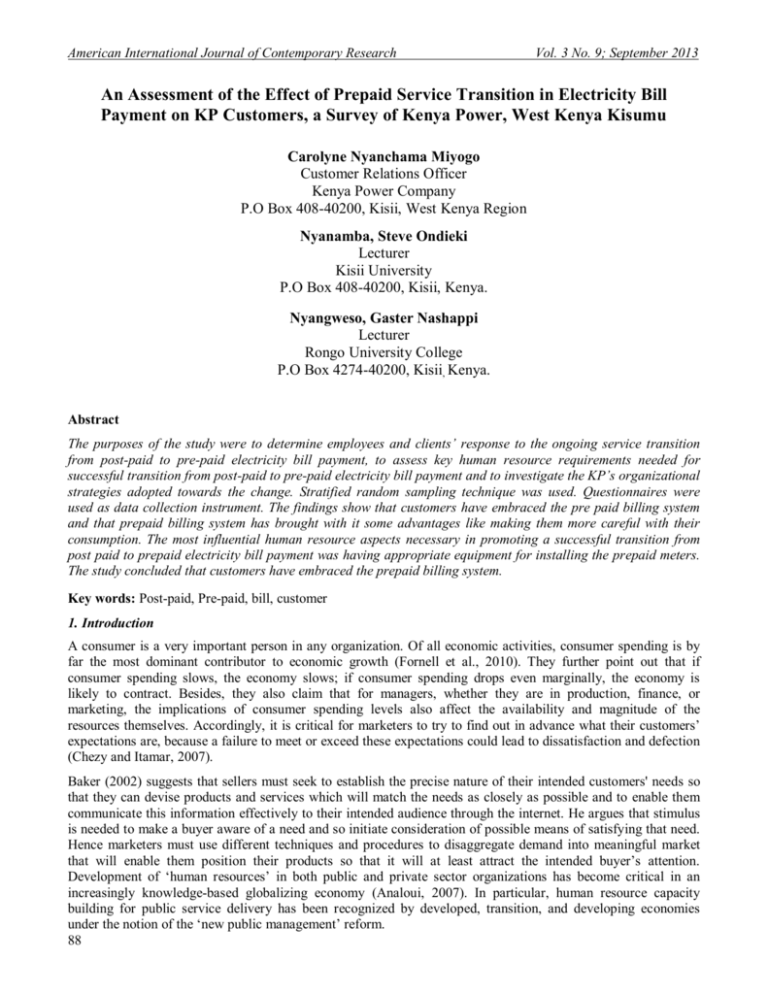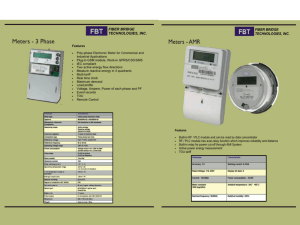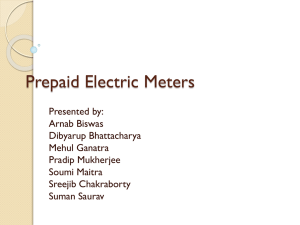Full Text - American International Journal of Contemporary Research
advertisement

American International Journal of Contemporary Research Vol. 3 No. 9; September 2013 An Assessment of the Effect of Prepaid Service Transition in Electricity Bill Payment on KP Customers, a Survey of Kenya Power, West Kenya Kisumu Carolyne Nyanchama Miyogo Customer Relations Officer Kenya Power Company P.O Box 408-40200, Kisii, West Kenya Region Nyanamba, Steve Ondieki Lecturer Kisii University P.O Box 408-40200, Kisii, Kenya. Nyangweso, Gaster Nashappi Lecturer Rongo University College P.O Box 4274-40200, Kisii, Kenya. Abstract The purposes of the study were to determine employees and clients’ response to the ongoing service transition from post-paid to pre-paid electricity bill payment, to assess key human resource requirements needed for successful transition from post-paid to pre-paid electricity bill payment and to investigate the KP’s organizational strategies adopted towards the change. Stratified random sampling technique was used. Questionnaires were used as data collection instrument. The findings show that customers have embraced the pre paid billing system and that prepaid billing system has brought with it some advantages like making them more careful with their consumption. The most influential human resource aspects necessary in promoting a successful transition from post paid to prepaid electricity bill payment was having appropriate equipment for installing the prepaid meters. The study concluded that customers have embraced the prepaid billing system. Key words: Post-paid, Pre-paid, bill, customer 1. Introduction A consumer is a very important person in any organization. Of all economic activities, consumer spending is by far the most dominant contributor to economic growth (Fornell et al., 2010). They further point out that if consumer spending slows, the economy slows; if consumer spending drops even marginally, the economy is likely to contract. Besides, they also claim that for managers, whether they are in production, finance, or marketing, the implications of consumer spending levels also affect the availability and magnitude of the resources themselves. Accordingly, it is critical for marketers to try to find out in advance what their customers’ expectations are, because a failure to meet or exceed these expectations could lead to dissatisfaction and defection (Chezy and Itamar, 2007). Baker (2002) suggests that sellers must seek to establish the precise nature of their intended customers' needs so that they can devise products and services which will match the needs as closely as possible and to enable them communicate this information effectively to their intended audience through the internet. He argues that stimulus is needed to make a buyer aware of a need and so initiate consideration of possible means of satisfying that need. Hence marketers must use different techniques and procedures to disaggregate demand into meaningful market that will enable them position their products so that it will at least attract the intended buyer’s attention. Development of ‘human resources’ in both public and private sector organizations has become critical in an increasingly knowledge-based globalizing economy (Analoui, 2007). In particular, human resource capacity building for public service delivery has been recognized by developed, transition, and developing economies under the notion of the ‘new public management’ reform. 88 © Center for Promoting Ideas, USA www.aijcrnet.com In the context of new public management (NPM) or public sector reform (PSR), decentralization, and human resource management and development (HRM/D) have been recognized as crucial strategic policy elements of concern in the implementation of reforms in both developed, transitional and developing countries. Hope (2001) argues that decentralization is seen as the means through which governments are able to provide high quality services that citizens value; for increasing managerial autonomy, particularly by reducing central administrative controls; for demanding, measuring and rewarding both organizational and individual performance. The World Bank observation is underscored by the reality that the most valuable and critical organizational resource is its people (Analoui, 2002). Recognizing that people conceive, plan, and execute all tasks, coordinate and organize inputs and produce outputs, it can thus be safely assumed that endeavors would succeed or fail because of the people involved (Powell, 2001). It is, therefore, not surprising that human resource management and development issues have been of great concern to public sector reformers, against the assumption that NPM reform is a management philosophy largely practiced in the private sector. The question has often been asked whether these philosophies and practices would work in the public domain with its bureaucratic and nonparticipative tendencies (Taylor, 2001; Hope, 2001). The Kenya Power and Lighting Company Limited (KPLC) is a limited liability company which transmits, distributes and retails electricity throughout Kenya. It is a public company listed at the Nairobi Securities Exchange (NSE). KPLC was incorporated in 1922 as the East African Power & Lighting Company (EAP&L). It changed its name to the Kenya Power and Lighting Company Limited (KPLC) in 1983 and later Kenya Power Company 2011. The majority shareholder in KP is the Government of Kenya and its institutions, while the rest is owned by private shareholders. Before a major power sector restructuring in 1997, KP also managed all generating stations on behalf of the Government. Currently, KP only manages some diesel-generating stations which are owned by the government, and which are isolated from the national interconnected grid. It currently has over 600,000 customers nationally. Therefore, this study clearly dwelt on addressing the determinants of successful transition in service provision specifically on electricity bill payment at Kenya Power Company, Kenya. In Kenya, over the recent decades, it was noted that, electricity bill payments was only made after consumption of electricity. However, with the drastic increase in non-payment of electricity bills by the KP customers, the company opted to slowly introduce pre-paid meters as a means of trying to reduce frequency of defaulters the defaulters. However, this adoption into post-paid electricity billing has raised regular complains by the electricity consumers to KP management. In addition, the KP image as been put into question by consumers of electricity. In spite of the rapid diffusion of postpayment systems, the arguments in favor of or against prepaid meters have not been comprehensively examined before, and neither has their welfare impact (Casarin and Nicollier, 2009). Therefore, this study assessed the effect of service transition in electricity bill payment on KP customers, specifically on electricity bill payment at Kenya Power Company, Western Kenya region. The objectives were to determine employees’ and clients’ response to the ongoing service transition from post-paid to pre-paid electricity bill payment, to assess key human resource requirements needed for successful transition from post-paid to prepaid electricity bill payment and to investigate the organizational strategies adopted towards change. 2. Literature Review Open systems perspective maintains that organizations performance is largely influenced by factors that are external to them. These external influences may be specific or general. The specific environment refers to the network of suppliers, distributors, government agencies, clients and competitors with which an organization interacts. The general environment encompasses cultural values, economic conditions and legal or political environment prevailing within the organization’s geographical locality. General systems theory is useful in explaining the environment under which the Kenya Power and Lighting Company operates. Closed systems perspective highlights on the organization’s probable internal strengths needed for successful performance, its subsystems and the nature and effects of their interdependence. Such strengths in the proposed study include responsible management, motivated and talented employees, effective communication channels and adaptive clients. Although useful in the understanding organization’s operating environment, the theory does not explain the strategies organization may employ when initiating and implementing change. It is this gap that Lewin’s theory of Change management sought to address. Lewin identified three steps to change: unfreezing, moving and refreezing (Levasseur, 2001). 89 American International Journal of Contemporary Research Vol. 3 No. 9; September 2013 Minimizing barriers to change and maximizing the opportunities of a change effort are accentuated in the unfreezing process. In the moving stage, recognition of need for change and the acceptance of change have to take place in the workforce. Accordingly, managers as change agents are expected to restore or reinforce the new system actively with all employees in the refreezing step. This simple three-step model explains the importance of implementing successful change by unfreezing the existing situation followed by change movement and making the new behaviours and norms absolute. According to Abrahamson (2000), effective change implementation is done by involving elements within an organization and engaging more employees gradually. Employees are to be constantly aware of proposed changes because they are the ones who make it happen. Managers, on the other hand, should collect feedback continuously by interacting with employees as well. By applying such concept of dynamic stability, an organization might look forward to a successful outcome in change implementation. The primary communication objective of the unfreezing stage should be to prepare organizational participants for the change. This has been called "readying" the organization, and the research results are clear concerning the wisdom of such preparation. If the change is more than marginally incremental, it is likely that resistance, some of it quite strong will surface because old values and methods are implicitly challenged. Some resistance will remain underground while it is gathering strength. The unfreezing stage involves a lot of organizational activity, such as planning, which has little objective outcome, but for which management will be held accountable by the rest of the workforce. Hence, a secondary objective of this stage is to account for this activity. During the unfreezing stage the status quo and the forces that sustain the status quo need to be called to question. The first thing to do is to communicate the need for a change by providing a specific rationale such as a discrepancy between necessary outcomes and actual outcomes or an opportunity that can only be captured through change. This first communication should come from the senior management person in charge of the unit. If the change is organization wide, the CEO should be the one who is the primary communicator. If it is confined to a specific sub-unit, it should be the unit manager who communicates, and so on. 2.2 Prepaid Electricity Billing Pre-paid electricity billing was first used in South Africa in mid 1980s. The primary objective was to supply electric power to low income neighborhoods at affordable rates (Stoner, 2009). The concerns for universal service in utilities have motivated firms and regulators to identify technological and regulatory options aimed at encouraging access, and making it easier for consumers to pay for their services (Casarin and Nicollier, 2009) Prepayment mechanism requires consumers to hold credit and then use the service until the credit is exhausted. In the case of electricity consumers use energy only when they have credit in the electricity account, a supply is discontinued when such credit is exhausted. Taking a cue from the South Africa’s success, countries such as United Kingdom, Turkey, India and Argentina adopted prepaid electric meters to extend electricity connections not only to poor urban neighborhoods but also to far flung rural residences (Tewari and Shah, 2003). More recently, faced with huge customer debt profile and revenue collection challenges, Power Holding Company of Nigeria and National Power Authority of Sierra Leone introduced the pre-paid electric meters in 2006 and 2007 respectively. These decisions were motivated by the need to boost revenue collections and limit debts to power distribution companies (Ogujor, 2007). However, the research revealed that while the introduction of the prepaid meter increases the revenue collection, it reduces revenue generation because it is reliability based. This means that the consumers were now careful with the way they used (consumed) electricity. As part its recommendation, the research noted that there was need for consumers to embraces the prepaid meters. It ensures that the consumer pays only for energy consumed and not the estimated bill in post paid (Ogujor and Otasowie, 2010). Since its incorporation in the 1920s as the East African Power & Lighting Company (EAP&L) and later in the 1980s as the Kenya Power and Lighting Company Ltd., the KP has been operating on post-paid electricity meters for both domestic and industrial energy users. Recently, the company launched on a pilot basis post-paid electricity meters for domestic users within Nairobi area and Kisumu town with an initial connections to 24,000 households. 90 © Center for Promoting Ideas, USA www.aijcrnet.com While in other countries the objectives for prepaid electric billing system were to increase access to electric energy by low income households and to boost revenue collection, the same may not be said of Kenya Power Company. But even with countries where the introduction of prepaid electric billing had clear objectives, it has never been established whether such objectives have ever been achieved, and if not why. The continued use of postpaid electric meters in countries like South Africa two and a half decades after the introduction of postpaid meters may point to possible challenges in the adoption of prepaid meters. There is virtually no study in Kenya (known to the researcher) that has attempted to investigate the extent to which prepaid electric meters have boosted revenue collection, and how employees and clients of power distribution companies have responded to organization’s transition from postpaid to prepaid electric meters. The prepayment technology in electricity bill payment was initially developed in South Africa in the late 1980s. The objective here was to supply energy to a large number of low-income and geographically dispersed users. The idea came into being the realization that low-income neighbourhood were unable to meet electricity costs accrued through postpaid payment system. The prepayment system was later adopted in India, Great Britain and Argentina (Estache et al., 2000). There are three steps involved in the working of a prepaid meter. First, the user purchases energy at the sales outlet and, as part of the operation, receives a credit slip and a supporting device that identifies the operation, which may be a voucher with an identification code or another with magnetic support. Second, the user utilizes the device to add on her/her new consumption credit, either by entering a code or inserting the magnetic medium into the interface unit, which in both cases will be possible only if the device identification, matches that of the meter. Third, the measuring unit then clears consumption of the amount of energy purchased and also displays, in real time, the available credit remaining for consumption. Fourth, the meter switches off when credit is exhausted, and it switches on again only when the device corresponding to a new purchase is inserted. This mechanism, essentially, requires that users pay for the delivery of goods or services before their consumption. In this way, consumers hold credit and then use the service until the credit is exhausted (Casarin and Nicollier, 2009). While arguing from economic perspectives, Tewari and Shah (2003) believe that prepaid system results in mixed financial fortunes to energy provider and consumers. For instance, prepayment systems may result in a decrease in metering, billing and disconnection and reconnection costs to energy provider. This is brought on by the fact that payment is made prior to consumption, which implies a significant improvement in revenue collection and a reduction in working capital. From the consumer’s perspective, prepayment systems may result in a better understanding of how much energy is being consumed, inducing more control of energy use and budget management. These analyses, however, ignore how consumers and employees of energy provider evaluate the prepayment system. Therefore, the views of consumers and employees of energy providers must also be critically examined since the success of billing transition from postpaid to prepaid system depend on among other factors; their positive contributions. 2.3 Employees’ and Clients’ Response to Organization Change Looking at transition from post payment to prepayment in the context of organization change, then it is vital to examine how key stakeholders - employees of KP and energy consumers- may respond to changes in electricity billing and payment system. Perceptions toward change may be negative or positive. While positive perception toward change is a boost to the organization in the short run, the organization must be aware of the diverse expectations that employees and consumers attach to change. Negative perception toward change often leads to resistance to change. Organizations therefore must be prepared to manage both optimism and resistance that change may invoke among their employees and or clients. From the foregoing, it is important that the views of employees and consumers of energy regarding the ongoing transition from postpaid to prepaid electricity billing system are critically examined. The relevance of consumers’ and employees’ of the energy provider is inherent in the fact that these changes might be highly correlated with changes in their welfare and the fact that they are also a relevant factor behind the success of any change in the organization. While it is appreciable that progress can only come through change, not everyone including the beneficiaries of such progressive change are willing and ready to embrace change. On the contrary, it is widely believed that most would resist change (Duck, 2004). 91 American International Journal of Contemporary Research Vol. 3 No. 9; September 2013 Nevertheless, previous studies indicate that prepaid meters are not necessarily a well-received innovation in some segments of society, to the extent that in some cases, society as a whole is reluctant to adopt the system (Tewari and Shah, 2003). For instance, the introduction of prepaid billing system in Argentina was received with much skepticism, with many arguing that it was meant to exploit them. But why even progressive change may be resisted is well captured by Pietersen (2002) who reckons that for many people, the prospect of change produces fear, uncertainty and doubt, more so if it is top-down and induced by the management. This observation is quite relevant to the proposed study. The current study endeavoured to examine the kinds of uncertainty and fears that the ongoing change at the KP has evoked on employees. But even more vital to the proposed study is how such fears and uncertainties may affect the performance of the ongoing change at the company. Indeed, some observers argue that a key potential of prepaid systems is that their implementation in small communities helps reduce the level of confrontation between the local utility and consumers (USAID, 2004). Such confrontations have been well documented from many Asian countries. Here in Kenya, numerous accounts of illegal connections of electricity and other public utility such as water in urban slums have been witnessed. Service providers of the affected services have been forced to seek the services of security in disconnecting these services. However, several attempts toward disconnections have proved futile as residents under the guidance of criminal gangs often reconnect the services as soon as KP and water companies leave the scene. What is not clear is whether the KP has considered urban slums, especially those that have persistently robbed them of revenue through illegal connections. Countries such as South Africa, Argentina and a number of Asian nations launched energy prepaid system through poor neighbourhoods before spreading the service to middle and eventually upper class neighbourhoods (Estache et al., 2000). The importance of investigating employees’ perception of the intended or ongoing change is fore grounded in the belief that change at organization level normally put employees and management at contrasting points. Whereas employees consider change as threatening their positions and status not only in the organization but also the society as a whole, management on the other hand perceives employees resistance to change as deliberate effort by employees to derail them from achieving organization’s strategic goals by introducing delays, costs, and instabilities (Cheng & Petrovic-Lazarevic, 2004). Employees’ fear and skepticism toward change is provoked by fear of losing jobs, status and other privileges provided by the status quo. Put in the context of the current study, it is possible that resistance may come from field staff such as meter readers, cashiers as electronic billing may render some of them redundant. But even more worrying may be the increased skill requirements that change may impose on the current employees. How then should management proceed in the face of a looming resistance? Employee and clients involvement in change development and implementation has been proposed as an advance way of managing future resistance to change (Stratman & Roth, 2002). Some of the ways through which employees and clients can be involved in change management in the organization include attending to employees concerns and making available support groups in the organization. While extending this discussion further, Wee (2000) argues that employees and clients involvement in the design and implementation of new business processes helps in boosting their morale in the change process. He, however, emphasized the need to engage every stakeholder in the change process. This, in his opinion is achievable through top-down and cross-functional communication to generate enthusiasm in the intended change. More recently, employee and client education has been proposed as one way of forestalling future resistance to change Hong and Kim (2002). Education, they observe involves supplying people with information required to understand the need for change. They further note that education can also be used to make the organization more receptive to the need for the change. Furthermore, information provided during the implementation of a change can be used to build support for a strategy that is succeeding or to redirect efforts in implementing a strategy that is not meeting expectations. In summary, managing the change effectively by acknowledging resistance as natural and expected, giving importance to employees’ concern, having regular and open communication, getting everyone's participation, and promoting skills and development are some of the ways to lower the organizational resistance. Employees are not really resisting the change, but rather they may be resisting the loss of the status, loss of pay, or loss of comfort. In order to understand the factors leading to the success or failure of the organization process, it is necessary to look at the capacity needed to be a successful operation to improve the conduct (Watson et al, 2002; Rogerson, 2001). 92 © Center for Promoting Ideas, USA www.aijcrnet.com It has been noted that organization research has been moving towards understanding skills and competencies that are required by the benefactors to function in all the areas related to business trade (Barreira, 2004). Sornes, Stephens, Saetre, and Browning (2004) discovered few differences between the use of information and communication technologies by knowledge workers of Norway and the United States. Travica (2008) investigated the concept of information culture as a component of organizational culture and explored its influence on the implementation of self-service software.” Within the discipline of information systems, the concept of culture is generally regarded as being very important.” (Avison & Myers, 2008) and Keen (2009) observe that the main source of sustainable competitive advantage through information technologies the most neglected: the IS culture. In their view, it makes much more sense to invest in the IS organization and build a culture, not a collection of jobs and tasks. The present study was based upon Chase’s (2002) grounded theory inquiry into IT professionals in the utility industry as constituting an occupational culture, and focused upon one of the propositions from that research. He further argues that the world-view of veteran technology professionals tends toward high resilience in the face of change. In Kenya, Njeje (2007) carried a research on the assessment of the levels of training and development in trade union and their effects on industry. A case study of KPLC-Nakuru. Her objectives were to assess the levels of training and development of the trade union officials in KPLC and its effects in the industry. The specific objectives were to determine the levels of training and development and to establish the frequency of training and development union officials (refresher courses), to assess the attitudes of the union officials towards the training and development programmes, and to establish the effects of training and development on the industry. From the research, it was established that the level of training and development of trade union officials at KPLC is still low because the officials were not aware of the training areas and their attitude towards training and development was still negative despite the fact that they believe that training will positively affect both their interest and organization’s interest. The research recommended that training and development should be conducted frequently and pre schedule to abridge the ever changing knowledge gap in the organization. Therefore, I can conclude that so far quite a few researches have been done in this area, and in particular, no research has been done on the determinants of successful transition in service provision specifically on electricity bill payment at Kenya Power Company. It’s because of this reason that this research was carried to fill the gap. 3. Methodology The involved a descriptive survey of KP customers in West Kenya, Kisumu. This research study targeted accessing information from all the consumers of Kisumu town. The respondents were selected employees in Kisumu branch and consumers who reside within the Arina Rolwe estate. The research targeted obtaining information from all the 201 KP employees and 1020 consumers within Arina Lolwe estate. Stratified random sampling was adapted to categorize the stakeholders as: company employees and consumers. The company employees were further stratified into: office personnel and field personnel. To obtain a sample, 15% of the accessible population that is, 31employees and 153 consumers were selected from each stratum using simple random sampling. This is in conformity with Mugenda and Mugenda (2003) who argues that for descriptive study, at least 10% of the accessible population is sufficient enough to form a sample. This percentage (15%) was chosen with an assumption that should there be non-response from some respondents, the final number of respondents will constitute over 10% of the whole population. The summary for the sample is provided in table 1. To meet the study’s pre-designed objectives; the researcher collected primary data from the 184 respondents using structured questionnaires which were designed to accommodate all the critical aspects covered in the identified variables. Data were analyzed using descriptive statistics where the mean, mode and median were used as measures of central tendencies. Frequency distributions were prepared from the questionnaire responses. The weighted mean were also applied to identify and evaluate the degree of influence and importance of each factor. The results of the analysis were summarized using tables, graphs and charts. 4. Findings 4.1 Preference of Billing System Respondents were asked to indicate their readiness to switch to their previous billing system, given the opportunity. The study revealed that 96 respondents were not ready to go back to their original billing system, while 26 were ready to go back to their previous billing system. The study further indicated that 13 respondents were undecided as to which billing system was preferred over the other. Lastly, 3 respondents seemed “very ready” to go back to the previous billing system, given a chance. 93 American International Journal of Contemporary Research Vol. 3 No. 9; September 2013 4.2 Cost of Billing for Post Paid Meters The study sought to compare the two billing system as far as monthly bills for consumers is concerned. The study found out that 92% of the respondents saw no noticeable difference in their billing system while 5% of the respondents were of the view that current bills were lower compared to the previous bills during the post paid billing system. However, 3% of the respondents were of the opinion that the current bills were dearer compared to those under post paid billing system. 4.3 Opinion about Shift to Prepaid Billing System Respondents were asked to give their opinions on various aspects since their shift to prepaid billing system. A five point Likert scale was provided on which various statements were rated. The responses were as indicated in table 1. The results indicate that the respondents “agreed” with the fact that pre paid billing system has made them be careful with their consumption. This was rated at 4.47 on a five point Likert scale. The respondents were “undecided” on whether or not they can encourage their colleagues to shift to prepaid billing. This statement was rated 3.38 on a five point Likert scale. Besides that, respondents didn’t seem to have noted any change in payment since they shifted to prepaid billing system. This statement was rated 2.75 on a five point Likert scale, implying “disagree” tending to “undecided”. Further still, the respondents seem not to have experienced more blackout since they shifted to current prepaid billing system. This statement was rated 2.59 on the five point Likert scale. However, the respondents “strongly disagreed” with the opinion that power consumption was less since they shifted to prepaid billing. This was rated 1.77 on the five point Likert scale. 4.4 Time Lapse before Prepaid Reconnection The respondents were asked to indicate how long it takes for the meter to be reconnected once power supply is disconnected due to exhausted token and upon purchase of another token. The results showed that 100% of the KP customers acknowledged immediate reconnection of their power upon the purchases of the token. 4.5 KP’s Response to Customer Complaints The study sought to determine how long it takes for the KP to respond to complaints. The study revealed that 44.93% of the respondents get their complaints attended to between 2 days and 1 week after reporting, while 22.46% of the respondents have their complaints responded to between 1 day and 2 days after reporting. Besides, 18.12% of the respondents were of the view that the KP responds to their complaints between 1 week and 2 weeks after they are reported. 13.77% of the respondents claimed that their complaints are addressed between 6 hours and 1 day after launching them. However, only 0.72% of the respondents stuck to the opinion that the KP attend to complaints within 6 hours after their launch. 4.6 Satisfaction with KP Services The research sought to know the extent of customers’ satisfaction with the KP services. The results were as recorded in figure 1. The result indicated that 61 respondents were “satisfied” with the KP’s service delivery while 47 of the respondents were “very satisfied” with KP’s service delivery. The study further indicated that 27 respondents were “dissatisfied” with KP’s service delivery while 3 respondents were “very dissatisfied” with the way the KP’s service were being delivered. 4.7 Opinion about KP’s Transition from Post Paid to Pre Paid The respondents were asked to give their description on the planned transition from post paid to pre paid. The results showed that 79% of the respondents rated the transition as “good” while 17% of the respondents rated it as “bad” and the remaining 4% were undecided on where to rate the transition. This implies that on average, the transition was carried out well. 4.8 Human Resource Requirements Needed for Successful Transition Respondents were asked to identify the various human resource aspects necessary in promoting a successful transition from post paid to pre paid electricity bill payment. A five point Likert scale was provided on which the respondents were to rate the aspects provided by the researcher. The study revealed that having appropriate equipment for installing the prepaid meters and being in-serviced on how to install prepaid meter are the most influential human resource aspects necessary in promoting a successful transition from post paid to prepaid electricity bill payment. These were rated 3.93 and 3.79 respectively on a five point Likert scale. 94 © Center for Promoting Ideas, USA www.aijcrnet.com However, the respondents felt that salary increment is “less influential” in boosting successful transition from post paid to prepaid billing system. This factor was rated 1.62 on the five point Likert scale. 4.9 Implementation of Change Process The study sought to establish the extent to which various aspects of change process were followed. . The research indicated that the KP management involved employees in sensitizing the consumers on the advantages of using the prepaid meters and also informed employees on the intention to change the meters. The respondents were in agreement with these statements, attaching weighted means of 4.10 and 4.03 respectively on a five point Likert scale. Further still, Besides, the respondents were involved in sensitizing the consumers on the use of the prepaid meters besides being given in-service training on how to install the new prepaid meters. These were rated at 4.03 and 4.00 respectively on a five point Likert scale. However, the respondents seemed undecided on whether ot not they were actively involved in the installation of the prepaid meters. This claim received a rating of 3.59 on a five point Likert scale. 5.1 Discussions The first objective was to determine employees’ and clients’ response to the ongoing service transition from postpaid to prepaid electricity bill payment. The study realized that 96 respondents were not ready to go back to their original billing system, while 26 were ready to go back to their previous billing system. The results in table 1 indicate that the respondents agreed with the fact that pre paid billing system has made them be careful with their consumption. This was rated at 4.47 on a five point Likert scale. The respondents were “undecided” on whether or not they can encourage their colleagues to shift to prepaid billing. This statement was rated 3.38. Besides that, respondents didn’t seem to have noted any change in payment since they shifted to prepaid billing system. This statement was rated 2.75 on a five point Likert scale. Further still, the respondents seem not to have experienced more blackout since they shifted to current prepaid billing system. This statement was rated 2.59 on the five point Likert scale. The results also indicate that 100% of the respondents had never experienced power disconnections since they were shifted to prepaid billing system. The second objective was to identify the human resource necessary for successful transition from postpaid to prepaid electricity bill system. The study revealed that having appropriate equipment for installing the prepaid meters and being in-serviced on how to install prepaid meter are the most influential human resource aspects necessary in promoting a successful transition from post paid to prepaid electricity bill payment. These were rated 3.93 and 3.79 respectively on a five point Likert scale. However, the respondents felt that salary increment is “less influential” in boosting successful transition from post paid to prepaid billing system. This factor was rated 1.62 on the five point Likert scale. The third objective was to establish the strategies that the KP has adopted towards implementing the change. The research revealed that the KP management involved employees in sensitizing the consumers on the advantages of using the prepaid meters and also informed employees on the intention to change the meters. The respondents were in agreement with these statements, attaching weighted means of 4.10 and 4.03 respectively on a five point Likert scale. Besides, the respondents were involved in sensitizing the consumers on the use of the prepaid meters besides being given in-service training on how to install the new prepaid meters. These were rated at 4.03 and 4.00 respectively on a five point Likert scale. However, the respondents seemed undecided on whether ot not they were actively involved in the installation of the prepaid meters. This claim received a rating of 3.59 on a five point Likert scale. These findings are shown in table 2. 5.2 Conclusion The findings from this study show that customers have embraced the prepaid billing system since the majority registered unwillingness to return to their original billing system. It was also established that the prepaid billing system has brought with it some advantages like reduced power disconnections besides making it customers be more careful with their consumption. Besides that, respondents seem not to have noted any change in payment since they shifted to the prepaid billing system. On the part of the management, the study revealed that installation of prepaid meters has greatly improved debt collection. It was also noted that in order for the company to fully and effectively implement the installation of the prepaid meters in the country, it must first ensure that appropriate equipment for installing the prepaid meters are availed and the existing manpower is in-serviced on how to install pre paid meters. 95 American International Journal of Contemporary Research Vol. 3 No. 9; September 2013 References Abrahamson, E. (2000). “Change Without Pain.” Harvard Business Review, 75-79. Analoui, F. (2002). “The Changing Patters of Human Resource Management”, Ashgate, Aldershot, UK. Ariel A. Casarin A.A and Nicollier L. (2009). “Prepaid Meters in Electricity. A Cost-Benefit Analysis Utilities at the Base of the Pyramid. Athlers Centre and University of San Diego, California, United States. Avison M. and Myers F (2008).Towards an integrative view of strategic human resource management. Human Resource Management Review, Vol.1, pp. 203-25. Baker T (2002). Manufacturing Employees and Technological Change. Journal of Labor Research, 12(3): 231246. Barreira (2004). Psychological and Implied Contracts in Organizations. Employee Responsibilities and Rights Journal, vol. 2: 121-139. Cheng, J. and Petrovic-Lazarevic, S. (2004). “The Role of Effective Leadership in Doing More with Less in Public Universities”. Paper presented at Global Business and Technology Association Sixth Annual Conference, Cape Town, South Africa Duck, J. (1993). “Managing Change: The Art of Balancing” Harvard Business Review, Vol.71(6):109-118 Estache, A., Foster, V., and Q. Wodon (2000). ‘Infrastructure Reform and the Poor. Learning From Latin America’s Experience’ LAC Regional Studies Program, WBI Studies in Development. Fayol, H .1918. (In French), “Administration Industrielle Et Générale; prévoyance, organization, commandment, coordination, control,” Paris, H. Dunod et E. Pinat Fornell, C., Rust, R.T and Dekimpe, M.G (2010). The Effect of Customer Satisfaction on ConsumerSpending Growth. Abstract. Journal of Marketing Research (JMR) Volume 47, Number 1. Available on http://www.marketingpower.com/AboutAMA/Pages/AMA%20Publications/AM A%20Journals/Journal%20of%20Marketing%20Research/TOCs/SUM_2010.1/Effect_of_Customer_Satis faction.aspx. Downloaded on 18th August 2013 Hong, K. K., & Kim, Y. G. (2002). The critical success factors for ERP implementation: An organizational fit perspective. Information & Management, vol. 40, 25–40. Hope, K. R. Sr. (2001). The new public management: Context and practice in Africa. International Public Management Journal, Vol. 4, pp.119-134 Levasseur, R. E. (2001). People Skills: Change Management Tools – Lewin’s Change Model. Interfaces, vol. 31(4): 71-73. Njeje N. (2007). Assessment of the Levels of Training and Development in Trade Union and Their Effects on Industry. Unpublished MBA report, Egerton University, Kenya. Njoroge, J. (2005). Power Quality in the Competitive Market: The Consumer Perspective on Monitoring, Reporting and Benchmarking of Service Quality”, 18th International Conference on Electricity Distribution, Turin.Session Two Ogujor, E.A (2007). Reliability Assessment of Electric Power Distribution: A case study of 2 x 15MVA, 33/11kV Ugbowo Injection Substation. PhD Thesis: University of Benin, Benin City. Nigeria. Ofir, C and Simonson, I (2007). The Effect of Stating Expectations on Customer Satisfaction and Shopping Experience (Abstract). Journal of Marketing Research, Vol. XLIV, No. 1, February 2007. Available at http://www.marketingpower.com/AboutAMA/Pages/AMA%20Publications/AMA%20Journals/Journal% 20of%20Marketing%20Research/TOCs/summary%20fe b%2007/Effectjmrfeb07.aspx. downloaded on 18th August 2013 Ogujor E.A. and Otasowie P. (2010). Pre-Paid Meter: Impact On Revenue Generation In Nigeria”. International Journal of Academic Research Vol. 2. No. 3. Pp. 54-57 Powell, C. (2001). A Leadership Primer, Department of the Army United States of America, Washington D. C. Rogerson, M (2001). Resistance and the Background Conversations of Change. Journal of Organizational Change Management. Vol. 15 (2): 105-121 Stoner, A. (2009). 22nd AMEU Technical Convention 36 AMEU Proceedings 2009: Pretoria: South Africa. A Paper Presented in A Conference on Future Global Energy Needs held in South Africa. Stratman, J. K., and Roth, A.V. (2002). Enterprise resource planning (ERP) competence constructs: Two-stage multi-item scale development and validation. Decision Sciences Journal, vol. 33, 601–626 96 © Center for Promoting Ideas, USA www.aijcrnet.com Sornes,M., Stephens B, Saetre T. and Browning S.(2004). “Centralisation and governance: Does decentralization improve public service delivery”? The World Bank PREM Notes No. 55, June 2001 Taylor, H. (2001). “Human resources management and new public management: Two sides of a coin that has low value in developing countries’ in W. McCourt and M. Minogue (Ed.).The Internationalization of Public Management: Reinventing the Third World State, Edward Elgar, Cheltenham. Tewari, D. D. and T. Shah, (2003). An Assessment of South African prepaid electricity experiment, Lessons learned, and their policy implications for developing countries. Energy Policy Vol. 31, 911 – 927 Wee, S. (2000). Juggling towards ERP success: Keep key success factors high. ERP News. Retrieved March 16, 2004, from http://www.erpnews.com/erpnews/erp904/02get.html Table 1: Rating of Opinions on Shift to Prepaid Billing System Strongly Agree 5 I am now careful with my consumption of electricity 83 I would encourage my colleagues to shift to prepaid 16 billing system I pay less since I shifted to the prepaid billing system 4 I experience more blackout since I shifted to prepaid 7 billing system The tokens are easily accessible whenever I need 2 them I wish to change to postpaid billing system given a 1 chance I spend little time at the KP to purchase a token 5 Prepaid meter blows my electronic gadgets frequently 0 due to excess current I now consume less power since I shifted to prepaid 0 billing STATEMENT Agree 4 45 54 Undecided 3 3 43 Disagree 2 6 17 Strongly Disagree 1 1 8 138 138 4.47 3.38 44 24 12 25 69 69 9 13 138 138 2.75 2.59 20 33 57 26 138 2.38 18 5 87 27 138 2.12 16 0 9 32 65 85 43 21 138 138 2.09 2.08 0 15 61 57 138 1.77 ________________________________ Table 2: Opinion on Shift top prepaid Billing System Strongly Agree 5 Agree 4 Undecided 3 Disagree 2 Strongly Disagree 1 5 23 0 1 0 29 4.10 5 22 0 2 0 29 4.03 We were involved in sensitizing the consumers on the use of the prepaid meters 5 21 2 1 0 29 4.03 We were given in-service training on how to install the new prepaid meters 9 15 1 4 0 29 4.00 We were actively involved in the installation of the prepaid meters 3 18 2 5 1 29 3.59 STATEMENT We were involved in sensitizing the consumers on the advantages of using the prepaid meters We were informed of the organization’s intention to adopt the new prepaid meters Figure 1: Customer’ Satisfaction with KP Services 97








